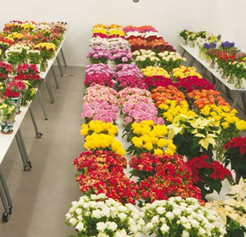By S.K. Bandyoa Padhay- ( Mr. Barnejee )
 Flower production costs in Kenya have increased significantly due to outbreak of disease like downy mildew, powdery mildew and botrytis and since this has become a limiting factor for production, it has become a concern for the investor.
Flower production costs in Kenya have increased significantly due to outbreak of disease like downy mildew, powdery mildew and botrytis and since this has become a limiting factor for production, it has become a concern for the investor.
Most growers use high amount of chemicals to control the disease, unaware of the fact that a timely and balanced mineral nutrition can prevent the disease as this enables the plants to develop the resistance against the disease, but in reality most growers resort to use of high level of chemicals which not only raises concern on environment and safety but also leaves economical consequences as well.
Essential plant nutrients in proper combination, concentration and ratio depending on the media type and climatic condition make the plants healthy and tolerant or resistant to disease where as the deficiency of them make the plants susceptible to diseases.
As soil pH, soil type, ionic forms of nutrients and their availability contributes the utilization and uptake of nutrients, a proper and balanced fertigation program can help the growers to achieve adequate disease control to a great extent.
This balanced fertigation program involves the composition of fertilizer stock solution in respect to all essential elements and their optimum level for physiological activities of the plant and also importance to be given for proper media management as media influence the nutrients availability to the plant for their utilization and uptake.
As it is known also that nutrient uptake greatly influenced by the prevailing weather condition, media pH, soil type (this determines the interval between irrigations), crop stage and variety, it is important to note that these factors to be kept in mind while composing stock solution and its discharge per certain volume of water. As it is well known that a balanced nutritional feeding makes the plants develop resistance by strengthening the cell wall forming mechanical barrier which makes the fungus difficult to penetrate the plant body, in addition to that, this also enables plant to produce defense or anti- fungal compounds.
There are many nutrients like Calcium and other elements when utilized in optimum level and in proper ratio the plant cell becomes stronger which makes the fungus difficult to penetrate plant body and there are other nutrients like Manganese, Copper and others which activate the enzymic activity to produce antifungal compounds. Potash plays an important role in metabolic activity of the plant as well in reducing the sensitivity of the disease. Sulphur as nutrient play a great role in reducing and inhibiting the disease directly or indirectly both in media and foliar disease as well.
An authentic and genuine water and media analysis should be done and studied thoroughly in terms of chemical composition and other aspects in order to decide on the amendment to be applied to make them suitable for plant growth and development and this in turn enables the plant to utilize the nutrients by increasing their availability if plants are receiving balanced fertigation program.
Therefore, a proper combination of fertigation program, cultural practices and cautious use of chemicals should be an essential approach for the grower to control diseases and successfully induce systemic acquired resistance to the plant against the disease and increase the productivity of the crop.
Mr. Barnejee is a nutrition consultant can be reached through ; barnejeesk20002@ yahoo.w.in, 254-703114885


